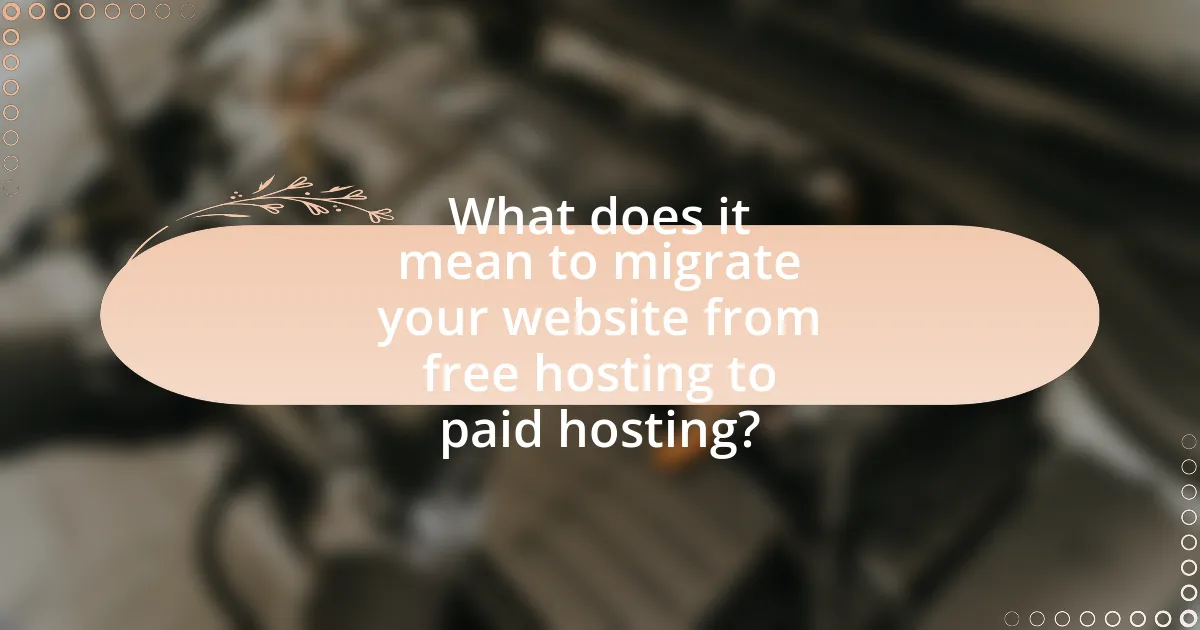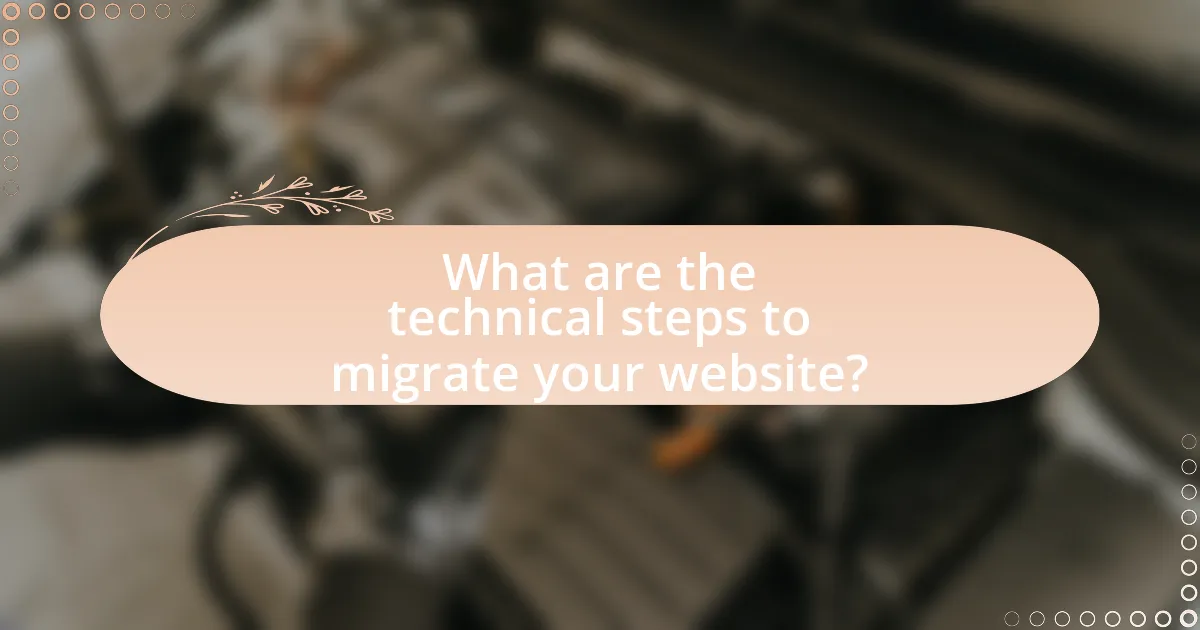Migrating your website from free hosting to paid hosting involves transferring files, databases, and configurations to a more robust hosting provider. This process enhances website performance, reliability, and security, addressing limitations commonly found in free hosting services, such as restricted bandwidth and lack of support. Key steps in the migration include planning, backing up data, selecting a suitable paid hosting plan, transferring files, updating DNS settings, and testing the website post-migration. The article outlines the benefits of paid hosting, the technical steps required for migration, and best practices for ensuring a successful transition, including ongoing maintenance and troubleshooting tips.

What does it mean to migrate your website from free hosting to paid hosting?
Migrating your website from free hosting to paid hosting means transferring your website’s files, databases, and configurations from a free hosting service to a paid hosting provider. This process typically involves selecting a paid hosting plan, backing up your website data, uploading it to the new server, and updating your domain’s DNS settings to point to the new hosting provider. Paid hosting often offers enhanced features such as increased storage, better performance, improved security, and customer support, which are not typically available with free hosting services.
Why should you consider migrating from free hosting to paid hosting?
Migrating from free hosting to paid hosting is essential for improved performance and reliability. Free hosting often comes with limitations such as slower loading speeds, restricted bandwidth, and frequent downtime, which can negatively impact user experience and SEO rankings. In contrast, paid hosting services typically offer enhanced resources, better security features, and customer support, ensuring that websites run smoothly and efficiently. For instance, a study by HostingAdvice found that websites on paid hosting platforms load 50% faster on average compared to those on free hosting, significantly improving user retention and engagement.
What limitations do free hosting services impose?
Free hosting services impose several limitations, including restricted storage space, bandwidth caps, and lack of customer support. These services often provide minimal disk space, typically ranging from 1GB to 5GB, which can hinder website growth. Bandwidth limitations can restrict the number of visitors a site can handle, often capping at 1GB to 10GB per month, leading to potential downtime during high traffic. Additionally, free hosting usually lacks technical support, leaving users to troubleshoot issues independently. Furthermore, many free hosts display ads on user websites, which can detract from the site’s professionalism and user experience.
How can paid hosting improve your website’s performance?
Paid hosting can significantly improve your website’s performance by providing dedicated resources, faster loading times, and enhanced reliability. Unlike free hosting, which often shares server resources among multiple users, paid hosting allocates specific bandwidth and storage to your site, reducing latency and increasing speed. For instance, a study by Google found that a one-second delay in loading time can lead to a 20% decrease in conversions, highlighting the importance of speed for user engagement. Additionally, paid hosting typically includes better security features and customer support, which can further enhance the overall performance and uptime of your website.
What are the key steps involved in the migration process?
The key steps involved in the migration process from free hosting to paid hosting include planning, backing up data, choosing a new hosting provider, transferring files, updating DNS settings, and testing the website.
Planning involves assessing the current website’s needs and selecting a suitable paid hosting plan. Backing up data ensures that all website files, databases, and configurations are securely saved before migration. Choosing a new hosting provider requires evaluating options based on performance, support, and pricing. Transferring files entails moving website content to the new server, often using FTP or a migration tool. Updating DNS settings is necessary to point the domain to the new hosting provider, which may take time to propagate. Finally, testing the website on the new host confirms that everything functions correctly post-migration.
How do you choose the right paid hosting provider?
To choose the right paid hosting provider, evaluate key factors such as reliability, performance, customer support, and pricing. Reliability is crucial; look for providers with a proven uptime record of 99.9% or higher, as this ensures your website remains accessible. Performance metrics, including server speed and load times, should also be assessed, with many providers offering benchmarks or speed tests. Customer support is vital; opt for hosts that provide 24/7 assistance through multiple channels, such as live chat, phone, and email, to resolve issues promptly. Lastly, compare pricing plans, ensuring they align with your budget while offering the necessary features, such as bandwidth and storage. Research shows that 70% of users prioritize uptime and support when selecting a hosting provider, highlighting the importance of these factors in decision-making.
What preparations are necessary before migration?
Before migration, it is essential to back up all website data, including files and databases. This ensures that no information is lost during the transition. Additionally, reviewing the current website’s structure and content helps identify any necessary updates or changes that should be made in the new hosting environment. It is also important to choose a suitable paid hosting plan that meets the website’s needs, considering factors such as bandwidth, storage, and support. Finally, informing users about the migration schedule can help minimize disruptions.

How do you prepare for the migration from free to paid hosting?
To prepare for the migration from free to paid hosting, first, select a suitable paid hosting provider that meets your website’s needs. This involves evaluating factors such as server performance, customer support, scalability, and pricing plans. Next, back up all website files and databases from the free hosting service to ensure no data is lost during the transition. Additionally, review and update your domain settings to point to the new hosting provider, which may include changing DNS records. Finally, test the website on the new hosting environment before fully switching over to confirm that all functionalities work as expected.
What data should you back up before migrating?
Before migrating, you should back up all website files, databases, and any associated email accounts. Website files include HTML, CSS, JavaScript, images, and other media that make up the site’s content. Databases, such as MySQL or PostgreSQL, store critical data like user information and site settings. Email accounts linked to the domain should also be backed up to prevent data loss during the transition. This comprehensive backup ensures that all essential components of the website are preserved, allowing for a smooth migration process without the risk of losing important data.
How do you create a complete backup of your website?
To create a complete backup of your website, use a combination of file and database backup methods. First, access your website’s file manager or use an FTP client to download all website files, including HTML, CSS, JavaScript, images, and any other assets. Next, export your database using tools like phpMyAdmin, which allows you to create a .sql file containing all your database content. This dual approach ensures that both your website’s files and its database are securely backed up, providing a comprehensive snapshot of your site. Regular backups are essential for data integrity and recovery, as they protect against data loss due to server failures or other issues.
What tools can assist in the backup process?
Tools that can assist in the backup process include software solutions like Acronis True Image, Backblaze, and Duplicati. Acronis True Image provides comprehensive backup options, including disk imaging and cloud storage, ensuring data integrity and recovery. Backblaze offers unlimited cloud backup for personal computers, making it easy to restore files when needed. Duplicati is an open-source backup solution that supports various storage backends and encryption, allowing users to securely back up their data. These tools are widely recognized for their effectiveness in safeguarding data during website migrations.
How do you select the right paid hosting plan for your needs?
To select the right paid hosting plan for your needs, first assess your website’s requirements, including expected traffic, storage space, and specific features like SSL certificates or email hosting. Evaluating these factors ensures that the chosen plan can accommodate your site’s growth and functionality. For instance, if your website anticipates high traffic, a plan with scalable resources and robust bandwidth is essential. Additionally, consider the level of customer support offered, as reliable assistance can be crucial during migration and ongoing management. Researching user reviews and comparing plans from reputable hosting providers can further validate your choice, ensuring it aligns with your operational needs and budget constraints.
What factors should you consider when evaluating hosting plans?
When evaluating hosting plans, consider factors such as performance, scalability, security, customer support, and pricing. Performance is crucial as it affects website speed and uptime; for instance, a reliable host should guarantee at least 99.9% uptime. Scalability allows your website to grow without needing a complete migration; many hosts offer easy upgrades. Security features, including SSL certificates and regular backups, protect your data and enhance user trust. Customer support should be accessible 24/7, as timely assistance is vital during issues. Finally, pricing should align with your budget while ensuring you receive adequate resources and features, as some low-cost plans may lack essential services.
How do different hosting types (shared, VPS, dedicated) compare?
Shared hosting is the most economical option, where multiple websites share a single server’s resources, making it suitable for small websites with low traffic. VPS (Virtual Private Server) hosting offers a middle ground, providing dedicated resources within a shared environment, which enhances performance and control, ideal for growing websites. Dedicated hosting provides an entire server for a single website, offering maximum performance, security, and customization, making it suitable for high-traffic sites or applications requiring significant resources. According to a 2021 survey by HostingAdvice, 70% of users on shared hosting reported limitations in performance, while 85% on dedicated hosting experienced improved site speed and reliability.

What are the technical steps to migrate your website?
To migrate your website, follow these technical steps: first, back up your website files and database from the free hosting provider. This ensures that all content is preserved during the transition. Next, choose a paid hosting provider that meets your website’s requirements, such as storage, bandwidth, and support. After selecting the provider, set up your new hosting account and configure the domain settings, including DNS records, to point to the new server. Then, upload the backed-up files and import the database to the new hosting environment. Finally, test the website on the new host to ensure everything functions correctly before updating the DNS settings to complete the migration. These steps are essential for a successful transition from free to paid hosting, minimizing downtime and data loss.
How do you transfer your website files to the new host?
To transfer your website files to the new host, you need to use an FTP client or a file manager provided by your hosting service. First, connect to your current hosting account using the FTP client, download all website files to your local computer, and then connect to your new hosting account to upload those files. This method is effective because FTP clients like FileZilla allow for easy file management and transfer, ensuring that all files, including HTML, CSS, images, and scripts, are accurately moved to the new server.
What methods can you use to upload files to the new server?
You can upload files to the new server using methods such as FTP (File Transfer Protocol), SFTP (Secure File Transfer Protocol), and web-based file managers. FTP allows for efficient file transfers between your local machine and the server, while SFTP provides an encrypted connection for enhanced security. Web-based file managers, often included in hosting control panels, enable users to upload files directly through a browser interface. These methods are widely used in web hosting environments, ensuring reliable and secure file transfers during the migration process.
How do you ensure all files are transferred correctly?
To ensure all files are transferred correctly during a website migration from free hosting to paid hosting, utilize a reliable file transfer protocol (FTP) client to facilitate the transfer process. An FTP client allows for the verification of file integrity through checksums or hashes, ensuring that each file is accurately copied without corruption. Additionally, maintaining a comprehensive backup of all files before initiating the transfer serves as a safeguard against data loss. According to a study by the International Journal of Computer Applications, using FTP clients can reduce transfer errors by up to 30% compared to manual methods, reinforcing the effectiveness of this approach.
How do you update your domain settings after migration?
To update your domain settings after migration, access your domain registrar’s control panel and modify the DNS records to point to the new hosting provider’s nameservers. This process typically involves replacing the existing nameservers with those provided by the new hosting service, which can usually be found in the welcome email or support documentation from the hosting provider. Accurate DNS configuration is crucial, as it ensures that visitors are directed to the correct server hosting your website.
What changes need to be made to your DNS settings?
To migrate your website from free hosting to paid hosting, you need to update your DNS settings by changing the nameservers to those provided by your new hosting provider. This change directs traffic from your domain to the new server, ensuring that visitors reach your website hosted on the paid plan. Typically, the new hosting provider will supply specific nameserver addresses, which you must enter in your domain registrar’s DNS management panel. This process is essential because it establishes the connection between your domain name and the new hosting environment, allowing for proper website functionality.
How long does it take for DNS changes to propagate?
DNS changes typically take between a few minutes to 48 hours to propagate fully. This variation is due to factors such as the Time to Live (TTL) settings configured on the DNS records, which dictate how long a DNS record is cached by servers and clients. For instance, if the TTL is set to one hour, changes may be visible within that timeframe, while longer TTLs can delay propagation. Additionally, different internet service providers may update their DNS caches at varying intervals, further influencing the overall propagation time.

What post-migration steps should you take to ensure success?
To ensure success after migrating your website from free hosting to paid hosting, you should verify that all website functionalities are working correctly. This includes checking links, forms, and any interactive elements to confirm they operate as intended. Additionally, you should update your DNS settings to point to the new hosting provider, ensuring that visitors reach the correct server. Monitoring website performance and loading speed is crucial, as a paid hosting service should provide improved performance compared to free hosting. Implementing security measures, such as SSL certificates, is also essential to protect user data and enhance trust. Regular backups should be established to safeguard your website content against potential data loss. These steps are validated by industry best practices, which emphasize the importance of functionality checks, DNS updates, performance monitoring, security enhancements, and data protection in successful website migrations.
How do you test your website after migration?
To test your website after migration, conduct a series of checks including functionality, performance, and SEO. First, verify that all links, forms, and interactive elements work correctly, as broken links can negatively impact user experience. Next, assess the website’s loading speed using tools like Google PageSpeed Insights, as performance issues can arise during migration. Additionally, check for proper indexing by searching for your site on Google and ensuring that it appears in search results, which is crucial for maintaining SEO rankings. Finally, review the website’s analytics to monitor traffic patterns and identify any discrepancies post-migration. These steps ensure that the migration was successful and that the website operates as intended.
What common issues should you look for after migration?
After migration, common issues to look for include broken links, missing images, and incorrect redirects. Broken links can occur if URLs change during the migration process, leading to 404 errors. Missing images may result from improper file transfers or changes in file paths. Incorrect redirects can cause traffic loss if old URLs do not properly redirect to new ones. Monitoring tools can help identify these issues, ensuring a smooth transition and maintaining website functionality.
How can you verify that your website is functioning properly?
To verify that your website is functioning properly, conduct a series of tests including checking page load speed, ensuring all links are operational, and confirming that forms and interactive elements work as intended. These tests can be performed using tools like Google PageSpeed Insights for speed analysis, and online link checkers to identify broken links. Additionally, monitoring user feedback and error logs can provide insights into any issues that may arise post-migration. Regularly performing these checks ensures that the website remains functional and user-friendly after transitioning from free to paid hosting.
What best practices should you follow after migrating to paid hosting?
After migrating to paid hosting, you should ensure that your website is fully functional and optimized for performance. This includes checking all links, images, and functionalities to confirm they work correctly in the new environment. Additionally, you should implement security measures such as SSL certificates and regular backups to protect your data. Monitoring website performance through analytics tools is also essential to identify any issues and improve user experience. These practices are validated by industry standards, which emphasize the importance of security and performance optimization in maintaining a successful online presence.
How can you optimize your website for better performance?
To optimize your website for better performance, focus on improving loading speed, enhancing server response time, and minimizing resource usage. Implementing techniques such as image compression, browser caching, and content delivery networks (CDNs) can significantly reduce load times. For instance, studies show that a one-second delay in page load time can lead to a 7% reduction in conversions, highlighting the importance of speed. Additionally, using tools like Google PageSpeed Insights can provide actionable recommendations tailored to your website’s specific needs, ensuring that performance enhancements are data-driven and effective.
What ongoing maintenance tasks should you consider?
Ongoing maintenance tasks to consider after migrating your website from free hosting to paid hosting include regular backups, software updates, security monitoring, and performance optimization. Regular backups ensure that your data is safe and can be restored in case of loss, while software updates keep your website secure and functioning properly by patching vulnerabilities. Security monitoring involves checking for malware and unauthorized access, which is crucial for protecting sensitive information. Performance optimization, such as optimizing images and minimizing code, enhances user experience and can improve search engine rankings. These tasks are essential for maintaining the integrity, security, and efficiency of your website post-migration.
What troubleshooting tips can help during the migration process?
During the migration process from free hosting to paid hosting, it is essential to ensure that all files and databases are backed up before starting the migration. This step prevents data loss and allows for recovery if issues arise. Additionally, verifying that the new hosting environment meets the technical requirements of the website is crucial; this includes checking PHP versions, database compatibility, and server configurations.
Another important troubleshooting tip is to update DNS settings accurately to point to the new server, as incorrect DNS configurations can lead to downtime. Testing the website on the new server using a temporary URL or IP address before making the DNS switch can help identify any issues.
Monitoring error logs during the migration can provide insights into any problems that occur, allowing for timely resolution. Finally, ensuring that all plugins and themes are compatible with the new hosting environment can prevent functionality issues post-migration.
How do you resolve common migration errors?
To resolve common migration errors, first, ensure that all files and databases are correctly transferred to the new hosting environment. This includes verifying file permissions, ensuring database connection strings are updated, and checking for missing files. For instance, a common error occurs when the database is not properly imported; using tools like phpMyAdmin can help confirm successful imports. Additionally, reviewing error logs can provide insights into specific issues, allowing for targeted troubleshooting. By systematically addressing these areas, most migration errors can be effectively resolved.
What resources are available for additional support?
For additional support during the migration of your website from free hosting to paid hosting, various resources are available. These include online forums such as Stack Overflow, where users can ask specific questions and receive expert advice from the community. Additionally, many hosting providers offer customer support services, including live chat, email, and phone support, which can assist with technical issues during the migration process. Furthermore, comprehensive guides and tutorials are available on websites like WPBeginner and SiteGround, providing step-by-step instructions tailored to different platforms. These resources collectively ensure that users have access to the necessary support for a smooth migration experience.